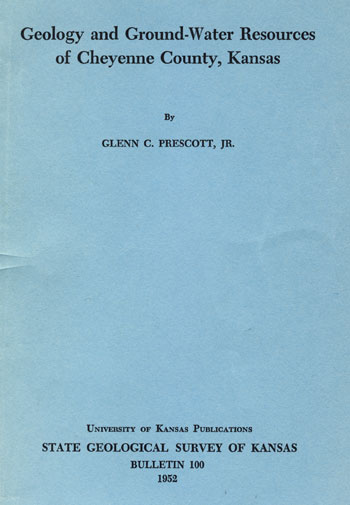Geology and Ground-water Resources of Cheyenne County, Kansas
By Glenn C. Prescott, Jr.

Originally published in 1953 as Kansas Geological Survey Bulletin 100. This is, in general, the original text as published. The information has not been updated. An Acrobat PDF version (56 MB) is also available, with plates available separately.
You may also wish to visit our web site on the Cheyenne County geologic map.
Abstract
This report describes the geography, geology, and ground-water resources of Cheyenne County in the northwestern corner of Kansas. The county has an area of about 1,027 square miles and in 1950 had 5,668 inhabitants. Cheyenne County lies within the High Plains section of the Great Plains physiographic province and consists of flat to rolling upland plains with the exception of the northern part of the county and the area adjacent to South Fork Republican River, which are deeply dissected. South Fork runs northeastward nearly through the center of the county and into Dundy County, Nebraska. South Fork and its tributaries drain much of Cheyenne County but an area in the vicinity of Bird City has no surface drainage outlet. The climate is semiarid, the normal annual precipitation being about 18 inches and the average annual temperature being about 52° F. Farming and livestock raising are the principal occupations in the county. A small acreage is under irrigation.
The outcropping rocks in Cheyenne County are sedimentary and range in age from late Cretaceous to Recent. The report contains a map showing the surficial geology and cross sections showing subsurface relations. Much of the county is underlain by the Tertiary Ogallala formation, which is generally covered by wind-blown silts of the Sanborn formation. The Pierre shale of late Cretaceous age, the oldest outcropping formation in the county, is exposed in several areas. The Ogallala is the principal water-bearing formation in the county but the alluvium of South Fork and other streams also yields water to wells.
The report contains a map showing the location of wells for which records were obtained and showing by means of shading the depths to water level. The depth to the water table ranges from less than 10 feet to nearly 275 feet. Included in the report is a contour map showing the shape and slope of the water table. The configuration of the Pierre shale also is shown by contours, and a map showing the thickness of water-bearing materials is included.
The ground-water reservoir is recharged principally by precipitation that falls within the county or in adjacent areas to the west, southwest, and south. Ground water is discharged through transpiration and evaporation, by springs, by discharge into streams, by subsurface movement into adjacent areas, and by wells. Most of the domestic, stock, public, and irrigation supplies are obtained from wells.
Irrigation is practiced to a limited extent in Cheyenne County along South Fork and in the uplands south of Bird City. Yields of wells in the alluvium of South Fork generally are small because of the thinness of the water-bearing materials. Yields of upland wells tapping the Ogallala formation are larger, but depths to water level are much greater in the uplands, increasing the cost of irrigating.
Analyses of 20 samples of ground water are given, together with a discussion of the principal chemical constituents in relation to use. The analyses indicate that waters from the Ogallala formation and alluvial deposits are suitable for most purposes although moderately hard. Water from alluvial deposits is generally higher in dissolved solids than water from the Ogallala formation. The field data upon which this report is based are given in tables. They include records of 361 wells and 1 spring, chemical analyses of 20 water samples from representative wells, and logs of 44 test holes and 2 irrigation wells.
Kansas Geological Survey, Geology
Placed on web Aug. 8, 2008; originally published April 1953.
Comments to webadmin@kgs.ku.edu
The URL for this page is http://www.kgs.ku.edu/General/Geology/Cheyenne/index.html